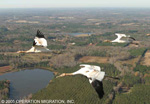Whooping
Crane Migration Update: March 24, 2006
Today's Report Includes:
- Eyes Up! Birds from Both Flocks Are Heading North
- Timing is Everything: Challenge Question #3
- Where Are the Whoopers of the Eastern Flock?
- Field Notes: Tom Stehn (Western Flock) and Mark Nipper (Eastern)
- ANSWERS! Craniac Treasure Hunt: Get to Know the Flock
- Challenge Question #4: Which Crane-Kids Wear the PTTs?
- Discussion of Challenge Question #2
We're still waiting for the cranes we'll map: the HY2005 ultralight-led chicks. Meanwhile, several of the Eastern flock's older birds are already home in Wisconsin! And in Texas, some of the Western flock have departed on the 2,500-mile migration to Canada. More news on both flocks follows, but first get out your journals and use the link below to note the weather where the cranes are coming from and headed to:
Then, get set to dig deeper with our next challenge question:
Timing is Everything: Challenge Question #3
|
Last time crane expert Tom Stehn asked you how cranes are rewarded for migrating at the right time. How do cranes “know” the “right” time? As you read today's update, and particularly Tom Stehn's report (below), keep alert for new information that will help you with this question; remember to send us your answers! |
|
| Challenge
Question #3: “What determines the best time for whooping cranes to migrate? Give statements to support your answer.” To respond to this Challenge Question, please follow these instructions. |
|
 |
Map:
WCEP
|
Where Are the Whoopers of the Eastern Flock?
Every spring we follow the migration of the very same Eastern
ultralight-led cranes we tracked the previous
fall. This
spring we will make a map
to show the unaided journey north of our 19 young cranes
(who aren't underway
yet). But the Eastern flock now includes 64 whooping cranes.
Where did they spend the winter? And where are they now?
This map answers the first question:
And this chart answers the second:
Field Notes: Cranes on the Wintering Grounds--and On Migration!
ANSWERS! Craniac Treasure Hunt: Get to Know the Flock
Which chick was not allowed to fly most of the very first ultralight migration (2001) because of his behavior? Last year (2005), which female produced the first egg ever laid by cranes in the new Eastern flock? Which 2005 chicks were called Jumblies, Poe, Waldo and Maya? Last time we gave you our Craniac Treasure Hunt questions. This time we give you the answers! Forget the TV show; these are the real SURVIVORS!
Challenge Question #4: Which Crane-Kids Wear the PTTs?
|
Explore
more: |
|
| Crane
#208 with PTT on his right leg and
radio transmitter on the left leg Photo Sara Zimorski |
|
The Craniac Treasure Hunt gave you a close look at the new Eastern flock, including the hatch year 2005 cranes making their first journey north. Now you know more about their personalities, and you're ready for the next challenge. So far, we've kept quiet about which THREE chicks are wearing satellite transmitters, called PTTs, besides their radio transmitters. A team of experts must choose which birds will wear the expensive PTTs. Think carefully about the 19 ultralight-led chicks and the 4 DAR (Direct Autumn Release) chicks. You have only 3 PTTs available. If you were the scientist, which birds would you most want extra measures for tracking their whereabouts? Then send us your answers to:
Challenge Question #4:
“Which 3 birds from all the HY2005 chicks would you pick to wear satellite transmitters (PTTs)? What are your reasons for each pick?”
To respond to this Challenge Question, please follow these instructions.
 |
Discussion
of Challenge Question #2: Why Not in Florida?
Surprising everyone, two of last year's DAR (Direct
Autumn Release) whooping
cranes were the first 2005 chicks to start their journey
north. But DAR
chicks #527 and #528 started out
from Tennessee. We asked: “Why
weren't these chicks in Florida,
like the other hatch year 2005 chicks?”
Each of this week's replies had a different and delightful
answer, and each showed a lot of
thought. There's something to learn from ALL
of
them. Well done, students! See answers
and our comments here:
The Next Crane Migration Update Will Be Posted on March 31, 2006.
Copyright
1997-2006 Journey
North. All Rights Reserved.
Please send all questions, comments, and suggestions to our
feedback form
![]()
![]()
![]()
![]()
![]()
![]()












